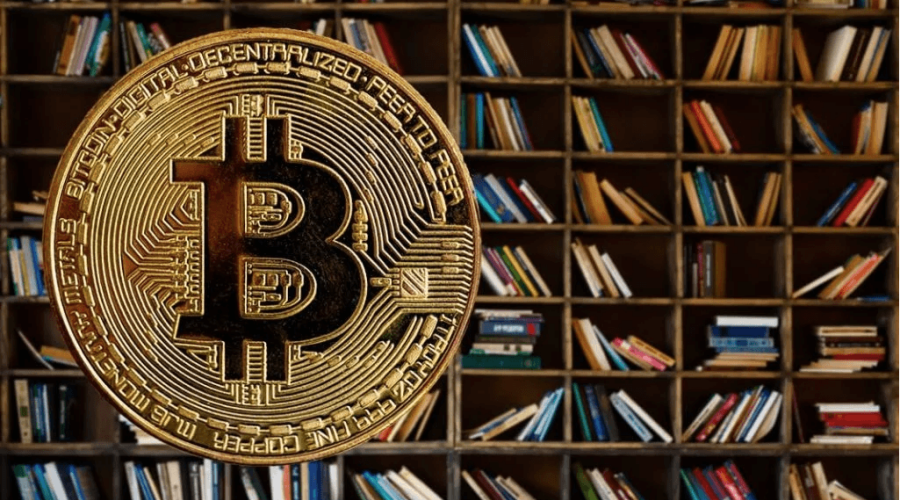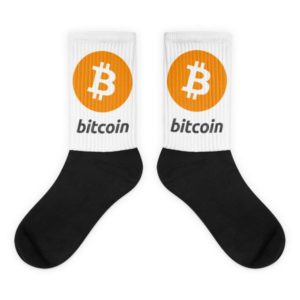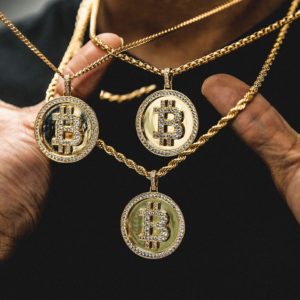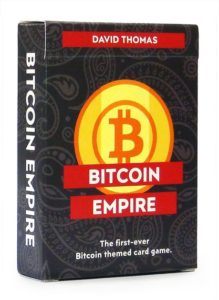Best Bitcoin Gifts for Crypto Enthusiast | Christmas 2019 - Coindoo
- Get link
- X
- Other Apps
Best Bitcoin Gifts for Crypto Enthusiast | Christmas 2019 - Coindoo |
- Best Bitcoin Gifts for Crypto Enthusiast | Christmas 2019 - Coindoo
- How to gamble using crypto - Decrypt
- The inside story of Binance’s explosive rise to power - Decrypt
| Best Bitcoin Gifts for Crypto Enthusiast | Christmas 2019 - Coindoo Posted: 24 Nov 2019 08:00 AM PST The days leading up to Christmas are fewer and fewer, and many are already panicking that they have no idea what gifts should they get for their friends and family. For those of you that are having issues finding the perfect Bitcoin gifts for your crypto enthusiast friends, we have put together a list with some items they might like to receive as presents. Hardware WalletsIf your friend has expressed his concerns about the security issues of the crypto world, then put his mind at ease by getting him one of the most secure forms of storage for digital assets. A hardware wallet is a physical cryptocurrency wallet that keeps the user's private keys in a hardware device. Compared to software or web wallets, they are practically invulnerable to hacks. The most recommended two products from this category are Ledger Nano X and Trezor Model T, but you can also opt for their older models Ledger Nano S and Trezor Model One, as they are much more affordable.
Books About Bitcoin and CryptoKnowing the ins and outs of the crypto and blockchain is sometimes difficult on your own, and scouring the many blogs and articles available online can be tiresome. Why not get a book that covers all the aspects in-depth? Andreas Antonopoulos, a prominent figure in the industry and a well-known blockchain educator, has written a series of books available both in paperback and ebook format. His book "Mastering Bitcoin: Programming the Open Blockchain" features a comprehensive glossary of blockchain lingo and explains how bitcoin came about and its underlying functions. This book is also great for those that want to learn the coding aspects of blockchain. Of course, there are many other books that are about bitcoin, such as "Early Bird Gets The Bitcoin" by Andrew K. Courey, "Bitcoin For Dummies" by Prypto, "Bitcoin From Beginner To Expert" by Christian Newman, and "Bitcoin: The Ultimate Guide to the World of Bitcoin" by Ikuya Takashima.  Socks
Clothes
One popular model features the bitcoin logo stylized on NASA t-shirts. Of course, you can also go for a Bitcoin hoodie for the ultimate Mr.-Robot-Hacker- vibe. ASIC MinersYou may not have the money to buy your friends bitcoin, but you could get them an ASIC mining rig to help them mine their own BTC. Bitmain, Halong, GekkoScience, Pangolin, Baikal, Ebang, and Canaan are all popular mining hardware producers, and their product line includes some of the best AISC miners for bitcoins. Graphics CardIf ASIC miners are a present that goes way over your budget, then you could get a graphics card from AMD or Nvidia as a gift. Graphics cards have the ability to mine various coins, but for bitcoin mining, the profits will be made much slower, as they have less computational power than ASICs. But, if the person you are giving this present to is not into serious mining, it should suffice. The graphics card can also be used to upgrade the power of your computer when playing games, so it's sort of a two-in-one gift. AccessoriesFor those who love to accessorize their outfit, there are a variety of Bitcoin-themed items that can be used to style up an outfit. There are belt buckles made out of stainless steel, vintage bitcoin watches with genuine leather, cufflinks, ties, hats, and all sorts of other items that will enhance the style of the wearer.  Jewelry
Of course, such jewelry is not only reserved for the ladies of the crypto revolutions; there are also many options for men. Card Games
For those looking to play more serious games, there are card games with Bitcoin with which you can play poker or blackjack. Why play a game of poker with spades, hearts, diamonds, or clubs, when you can get a royal flush with Bitcoin, Ethereum, Litecoin, and NEO? A Blockchain PhoneThis is a tech product that was released a year or two ago, so you might find it at really steep prices. HTC and Sirin Labs are two of the companies that have launched a blockchain phone that also features cold storage functions, increased security, and other functionalities derived from blockchain technology. A crypto enthusiast can store his bitcoin directly on his phone and has the same security of a hardware wallet, or makes payments with his digital funds. The Exodus and Finney smartphones are around the $1,000 mark, which is a lot, but you have plenty of other budget-friendly Bitcoin gifts on our list.  A Phone Case
ConclusionWe hope you will take our list into consideration when you will start shopping for bitcoin gifts for the Christmas season. May you be the greatest Crypto Santa of all! Featured image: Pinterest |
| How to gamble using crypto - Decrypt Posted: 19 Nov 2019 06:14 AM PST  Investing in cryptocurrencies may have been called gambling by some—but if you're holding crypto and you're looking to wager on real games of chance, there are plenty of options for gambling with your hard-earned Bitcoin. Unsurprisingly, there are loads of ways to gamble online with crypto, and it's not difficult to see why. Crypto affords users a level of anonymity they wouldn't have with fiat money deposited from banks or credit cards, and depending on the platform, the casino may not be affected by gambling restrictions in certain locations. It's a seemingly ideal use case for decentralized technology and anonymous currency, and many gambling sites have sprung up to meet the demand. Looking to gamble with Bitcoin, ether, EOS, or another top cryptocurrency? Here's a look at how you can do just that, along with some of the unique elements and restrictions that come along with it. Decrypt is not advocating or vouching for the quality of any of the dapps or online casinos mentioned here—we are simply highlighting popular options. Decentralized gamblingThere's a rising number of decentralized gambling apps that take place directly on the blockchain as dapps. You can find a handy listing of the most popular ones at DappRadar. Many of the most popular gambling dapps are based on TRON (TRX), as its 2,000 transactions-per-second turnover rate allows services like these to thrive. As of writing, the most popular gambling dapps include WINk, which also supports DICE (TRC20) and BTT (TRC10) in addition to TRX. WINk, billed as "world's first trustless, permission-less, and high-performance e-gaming platform on the TRON network," has a volume of more than $14 million in a seven-day period, with more than two million transactions and 5,000+ users. It offers games based on its DICE coin, as well as live slots, table games, and more. Another popular option is RocketGame, which supports TRX and ROCKET (TRC20) and has a variety of player versus player (PvP) games. RocketGame shows a volume of $1.8 million over the last week, with about 3,500 users and more than 450,000 transactions. Experience Web 3.0.Be the first to get Decrypt Members. A new type of account built on blockchain. Online casinosThere are also many online casinos that are not decentralized apps than run off of a blockchain, but rather are traditional web platforms that let you deposit and withdraw cryptocurrency to play. Given the more standard approach, these sites can potentially offer a much larger selection of games and can also accept a wider array of coins. For example, FortuneJack is a popular crypto-gambling site with hundreds of different games—dice, slots, blackjack, poker, roulette, and many more. It also supports nine different coins, letting you deposit and withdraw the following cryptocurrencies: Bitcoin, Litecoin, Dogecoin, Ethereum, Zcash, TRON, Dash, Bitcoin Cash, and Monero. Other options along this line include BetChain, which similarly has a huge stash of games and both accepts and pays out in Bitcoin, Bitcoin Cash, Litecoin, Ethereum, Dogecoin, and Tether. BetChain also accepts and pays out in Euros and other fiat currencies too. DuckDice, another site, only offers a single dice game—but in addition to Bitcoin, it accepts more than 300 altcoins via partner CoinSwitch, which converts them to Bitcoin during the process.
Things to knowMany crypto gambling sites promise "Provably Fair" games. What does that mean? Well, the more reputable crypto casinos have implemented technology that allows you to verify that the game isn't simply cheating you out of wins. You are given a server hash, server seed, and client seed, which you can put into a verifying script to affirm the game's legitimacy. Some crypto casinos also feature a Bitcoin or other crypto coin faucet, which gives you a very, very small chunk of free currency to play with on a semi-regular basis. This may be supported by ads, special offers, surveys, and other things you might not want to mess with—but it'll give you a little bit of coin to start gambling with if you don't want to empty your own wallet. Finally, be aware that regional restrictions still come into play with many online gambling sites. For example, some sites were completely blocked off to this US-based writer, while others put the onus on players to be aware of their local gambling laws. If you're new to online gambling, then you should look up what's legal and what's not in your country or state. |
| The inside story of Binance’s explosive rise to power - Decrypt Posted: 16 Nov 2019 12:00 AM PST  NEW YORK—Not too long ago, I was shacked up in a cheap hostel, in Manhattan. The window was open to counteract the heat of the stiff radiator, which couldn't be turned off on a hot day in May. My colleague was nowhere to be seen and I'd just received a shocking message about Binance, the largest crypto exchange in the world. That afternoon, the exchange had been hacked. It had lost 7,000 bitcoin, which was then worth a staggering $40 million. Crypto exchange hacks are all too common in this world. There have been hundreds of such thefts, with that swindle taking the total of all money lost at all crypto exchanges to $1.35 billion. Until now, Binance had withstood the barrels of attacks, but this sudden breach triggered it to effectively shut up shop for an entire week—an eternity in crypto. And though Binance offhandedly covered the $40 million out of its rainy-day fund, the damage to its reputation had already been done. "At that moment, I was truly shaken. It was from that sting in having that streak broken," Binance's chief growth officer, Ted Lin, told me later, in an interview. Lin, who's been at the young company since its early days, added: "It was a watershed moment." Binance was just two years old, and while this was hardly fatal, it was not only a watershed moment but a blow to one of the fastest rising companies in crypto. It had taken the company a scant eight months in 2017 and early 2018 to become the most active exchange in the world. At the peak of the crypto bubble, Binance said its 7.9 million users were trading some $10 billion daily. Well after that bubble, it now has more than 10 million users, 600 employees, and made $500 million in profits in its first year alone. (Binance is not a public company but—for the first year at least—it claimed it burned 20 percent of its monthly profits in its native BNB token, which it reports. So people calculated backwards to estimate profitability.) Forget the tech giants of old—the speed of crypto success stories, like Binance, puts crypto businesses in a league of their own. But as I sat there sweating in that nasty little hovel in NYC—after knocking out a breaking news story on the hack so quickly I misspelled Bitcoin in the headline—I thought about how little was known about Binance. I knew that the exchange was run by its charismatic founder Changpeng Zhao, 43, adored by his 450,000 Twitter followers as "CZ." I knew that he had founded it in Shanghai—and that then, almost overnight, it had disappeared onto the telecosm, as stateless and decentralized as true crypto itself. I also knew tons of little facts and figures from having written a slew of stories about the place. But it still didn't add up for me. How was it possible that the biggest exchange in the world could move billions of dollars in trades a day, and it didn't have an ostentatious "campus" in Palo Alto? How could it shrug off a $40 million heist as simply a learning experience? And as one of the most important companies in crypto, where was it headed? Over the next few months, I interviewed as many current and former employees, from Zhao on down, as I could. What I discovered was that the world's biggest crypto exchange isn't so much a formal company as it is an underground rebellion—a repudiation of the legacy financial system. As Zhao once told an interviewer, his exchange wants to "make a difference to the world and use crypto to do the good things. It's also about spreading crypto, or the freedom of money." Binance is strategically building something much bigger than a crypto exchange: They are building the future of finance. Tushar Jain Binance's big idea—"freedom of money"—means that the exchange hopes to help anyone, anywhere, easily send money to each other around the world. It's a lofty goal, and really, that's just the start. If Binance succeeds, it'll make history and could even become a financial layer embedded into the Internet itself—but, like everything else in Binance's history, it will surely be a struggle. The risk takerOne night in August, 2013 would fundamentally change Zhao's life. He was playing poker in Shanghai with two of his friends, BTCC Bitcoin exchange founder Bobby Lee and Ron Cao, who was then a partner at Lightspeed Ventures. Cao kept saying something that sounded like, "Bit Coin,"—Cao said it as two separate words. It was the first time Zhao ever heard of it. "You should do a startup in Bit Coin, or blockchain," he heard Cao say. Then, Lee advised: You should put 10 percent of your net worth into it. If it goes to zero, you lose 10 percent. There is a higher chance it will go 10X, and you double your net worth. He wasn't joking. And Zhao was intrigued. He ended up raising him one: A short time later, he sold his house for $1 million and put it all on Bitcoin. BTC was then selling for $600 a coin. Zhao told Decrypt he still hasn't touched it—despite Bitcoin's price dropping as low as $200 at times. That nest egg is now worth $17 million. The man has never been risk averse. He was born in Shanghai to a high school teacher and a professor. He moved with his family when he was a child to Canada, where he was raised. He received an undergraduate degree in computer science at McGill University, in Montreal, and from there, went off in search of his fortune, treating the world as one giant playground—rather than individual countries marked by irksome borders. Zhao started in Tokyo, matching trade orders on the Tokyo Stock Exchange for four years, before moving to New York to work for another four years at Bloomberg's Tradebook, on its futures trading offering. He returned to Shanghai in 2005 to start his own company, Fusion Systems, which built high-performance trading software for global banks. He had spent eight years there when he started investing in Bitcoin. Even though Zhao's Bitcoin holdings remained in the red, he was convinced that crypto was the future. He learned more and more, pulled short stints at crypto wallet provider Blockchain, and crypto exchange OKEx, and began to think about starting his own exchange. Binance CEO Changpeng Zhao stands against the backdrop of London's financial district. Image: Decrypt First though, he came up with an intermediate step: he launched his second company, Bijie Technology, which made cloud-based exchange software. Cloud computing was just getting off the ground, and giants such as Amazon, Microsoft and Google were convincing companies to ditch their local servers and run their businesses remotely, on their giant server farms. By 2011, the New York Stock Exchange was offering cloud-based, software-as-a-service for its clients, who were running high-performance trading systems. Soon, many exchanges would follow suit. At its peak, Bijie supplied 30 exchanges with cloud-based exchange software. But Zhao was thinking bigger. ICO feverNearly four years after getting into Bitcoin, on June 14, 2017, Zhao was dining with a who's who of the Asian crypto community, including Neo founder Da Hongfei and Monaco (now Crypto.com) founder Kris Marszalek, in Chengdu, China. The discussion concerned initial coin offerings—startups were getting funded on the strength of little more than a good idea, a white paper and by issuing their own token. Zhao knew, in general, what ICOs were. But as he heard the men talk, he realized this was how he'd launch his crypto exchange. He left the dinner full of excitement and quickly hammered out a whitepaper, in English and Chinese, laying out the idea for Binance. The name is a portmanteau of "binary" and "finance," to highlight that there were now two types of money in the world: crypto and fiat. Zhao would build the exchange to handle crypto-to-crypto trades only, circumnavigating the stringent regulations—and cost—that come with handling fiat money. "With your help, Binance will build a world-class crypto exchange, powering the future of crypto finance," the whitepaper promised. All it needed was its own token. A token is bornPeople bought tokens in an ICO based on the promise of revolutionary new technology. But Binance had real, working code: Binance would be the first crypto exchange built on Bijie's exchange-in-the-cloud software. In fact, while the token raise was underway, Bijie—the entire company—simply pivoted from being a software provider to being a crypto exchange in the cloud. And changed its name to Binance. In just two weeks, investors bought into the token sale, which raised $15 million by July 2. Trading of its new token, BNB, would go live in twelve days. The staff of 30 was still holed up in the erstwhile Bijie office. Employees remember it as being utterly devoid of personality. Its walls were whitewashed and it was so small that people ate at their desks—there wasn't a lunchroom. The office had "no beauty about it at all," recalled Lin. Though bottles of champagne were readied for the exchange's launch, they were never popped. Almost from the moment it launched, Binance seemed like it would be a disaster. Investors who bought up Binance Coin believed that it would see 5-10X returns. Instead, when it launched on July 25, 2017, it quickly lost 20 percent of its value. "It was the highest pressure period of my life," Zhao told me recently. He tried everything, from listing more altcoins on Binance, to livestreamed Ask-Me-Anything videos, to attract attention to the exchange. He even tried to buy up the coin with his own money, to no avail. On August 8, Yi He, 33, born in China's Sichuan province, joined Binance as a co-founder and CMO. Zhao knew her from OKcoin—she was the one who persuaded him to come onboard the crypto exchange as CTO. Later, At the time, she said, in a blog post, "This world is crazier than you think, and I am part of this crazy world. Therefore, I would like to go back to my battlefield, join Binance, in order to complete my mission." The day He came onboard, the price of BNB awoke, and blew up 1,800 percent in just two weeks, rising from $0.13 to $2.45. But Binance's problems were hardly over. Binance's escape from ChinaAt this time, the media was blowing plenty of hot air into the growing crypto bubble. Binance couldn't hire people quickly enough. And when it did find someone to hire, it had nowhere to put them, with three tiny desks for every five people. Zhao said: "It was a cramped office, but very high energy. Everyone was yelling and screaming over each other." Then, in late August, Zhao began to hear rumours that the Chinese government had its eye on crypto exchanges, including Binance. That was not a good thing. Experience Web 3.0.Be the first to get Decrypt Members. A new type of account built on blockchain. Sometimes, Internet companies that attracted the unwanted attention of the Government were "invited to tea" where the situation was ironed out with officials. "There was never any official communication at all," said Zhao. "It was mostly rumours and more rumours. But the rumours were getting intensive enough we figured there was probably something material." He could shut Binance, and let customers withdraw all their money. Or he could take his exchange, and run. He ran. But this wasn't the Great Escape. If you had been watching Binance's office, you wouldn't notice anything out of the usual. People continued to clatter away at keyboards in a cramped office. But what they were doing, was escaping—moving all of Binance's cloud operations over to Amazon Web Services (AWS), headquartered in the U.S., far beyond China's Great Firewall. At the time, Binance had more than 200 cloud-based servers, hosted by the Chinese conglomerate, Alibaba. Its great escape wasn't dangerous. But it was technically difficult and time consuming. "Some people joked that if we moved the servers by airplane it would probably take the same amount of time," Zhao said. Finally, on the night of August 29, the team pushed itself to the limit and got everything uploaded to AWS. By morning light, they were finished. Zhao said he then moved his team out of Shanghai, "as fast as we could. Some of them were Chinese nationals and required visas, so it took a bit of time to organize." Others had never been outside of China. "It was a challenge," he said. They decamped to Japan, a country that had legalized crypto earlier that year, where Zhao believed his "basic Japanese" would help get things underway. Riding the Bitcoin bull runFrom September to December, 2017, the price of Bitcoin soared, from $3,000 to $20,000—an astonishing 570 percent. People were queueing up to get into crypto exchanges as if they were Walmart shoppers on Black Friday. The chaos on the outside was mirrored by the mayhem on the inside. "It was one of those rushes you're just not prepared for. It was beyond our imagination, this inrush of popularity," said Lin. The biggest problem was that Binance couldn't let just anyone onto its trading platform. All new users had to be ID'd at the door with a time-consuming process called know-your-customer (KYC) protocols. And that created a huge backlog, as well as related support work. "At one point, we had 45,000 pending KYC applications, with a constant stream of new applicants rolling in," recalled one early Binance staff member. Zhao, He and Binance staff celebrate the exchange reaching number one by trading volume. Image: Binance "I had to take some of the customer calls myself," said Lin. "If there were additional tickets that overflowed into non-English speaking members, any of us who could help translate would jump in and help. It was a startup-scramble mode." The few that made it into the exchanges pushed trading volume to record levels. At the peak, daily trading volume across all exchanges and coins reached $60 billion; Binance saw $10 billion change hands on one, gorgeous, record-setting day. While this was cause for celebration, there was a flipside. The exchange had grown so big and was holding so much money, it now had a giant target on its back. Cancelled in JapanAll bubbles must pop, and when this one did, it was in some ways good news: Things started to settle down at Binance into a pleasant, workable rhythm. But on the night of March 7, 2018, some of the exchange's remote workers were having drinks in a bar some distance from the Tokyo office. Zhao happened to be passing, so he joined them. And suddenly, Binance phones started buzzing. "It was nearly midnight when the first reports of irregular trading activity started flowing in," one employee who was working operations later told me. "I notified the others immediately." Hackers had created fake Google ads to trick users into entering their Binance login details on fake websites. They then drained those accounts, and bought up the bargain coins using other Binance accounts, in an attempt to hide their tracks. The Binance team moved quickly and were able to stop the coins from leaving the exchange by shutting off the attackers' withdrawals. Then they were able to roll back the trades to reimburse the affected users. No money was ultimately lost. But reputation was. Bad press followed, and two weeks after the hack, the Japanese Financial Services Authority demanded that Binance get an exchange license. The license would carry strict restrictions—including limiting the number of different coins that could be traded on the exchange. That was a non starter, so once again, the team took flight. This time, Zhao decided to make the relatively regulation-free island of Malta its home. Malta's Prime Minister himself, Joseph Muscat—welcomed Binance to the island, which was attempting to become a crypto haven. The company "officially" moved to Malta. Only it didn't, not really. Binance's disappearing actThere was no need for any employees to go to Malta. Zhao realized that his people could live wherever they liked. According to Zhao himself, at this point, Binance was not based anywhere. Employees wanted to work from home, and remotely. "We were growing internationally, we had users in every country," Zhao said. "It was a growing trend to have people work in distributed locations." The diaspora began. After experimenting with various messaging apps, employees ended up using messaging apps, including Telegram—which is popular in the crypto community and has no limits on group chats. Employees started organizing workflows, events, almost everything through the apps. It was a decentralized business run by a distributed company, true Web3 mechanics. This world is crazier than you think, and I am part of this crazy world. Yi He "Experimenting with a distributed team first hand, we found it was an edge. It's not perfect in how fast we can communicate, but it's an optimization between efficiency and being effective by being close to the market and time zone we want to serve," said Lin. But it put a strain on the employees. The exchange was up 24 hours a day— and so were some of the more obsessive employees. "It's very hard to organize everything. To do all this, someone has to sacrifice their night-time or early morning time," said Ella Zhang, head of Binance Labs. It was common for staff to work at all hours, taking naps when they couldn't stay awake any longer. Although this radical way of operating took its toll, it enabled Binance to adapt to the round-the-clock demands of the crypto market, and capitalize on it. That which doesn't kill us makes us strongerThe hackers that hit Binance in Tokyo were nothing compared to the hack that occurred early on the evening of May 7, 2019. The hackers had used multiple techniques, including phishing (like in the first attack in March, 2018) and viruses to gain control of several user accounts. One transaction managed to bypass Binance's pre-withdrawal checks; it nicked 7,000 bitcoin from Binance's "hot wallet." Once that "trade" happened, alarms went off. The tech team immediately paused withdrawals to try to stop the bleeding. They decided to keep trading going, figuring that without withdrawals, the damage would be contained. At the same time, they focused on preventing the hacker from continuing to attack the system. The team phoned Zhao, waking him up at 2 a.m. in Singapore. He was shocked, swore a little, but after a few seconds, he calmed down. "We have a simple script," he told me later. "Stop the bleed, prevent, review, communicate, fix, relaunch—that's how we handle it." After the breach was contained, Zhao announced that Binance would close for an entire week. Anyone on the exchange could keep trading, but nobody would be able to bring new money onto the exchange—or take any out. For the first four days, a SWAT team of 40 people worked through the night making fixes and upgrading the security of the exchange, while mostly ignoring the Ikea beds that had been rolled into makeshift offices around the world. The hackers have yet to be found and the investigation is ongoing. "We believe it was a large group effort. Extremely sophisticated," Zhao said, adding, "We are still working with multiple law enforcement to try to track some of those people down." The DAO of BinanceBinance has been insanely busy these past 12 months. Every day brings a new announcement: First leverage trading, then margin trading. Now, lending services, staking rewards and peer-to-peer trading. For its piece de resistance, it partnered with a U.S. entity, led by former Ripple executive Catherine Coley, to launch an American outpost. Binance.US opened an office in San Francisco, not far from its local rival Coinbase, and trading started on September 24. In a research paper last week, Tushar Jain, managing partner at Multicoin Capital (which invests in BNB tokens, among other things) described the frenetic pace as an example of what the Silicon Valley VC, Reid Hoffman, calls "blitzscaling." Hoffman says that's what happens when a great first-mover startup rapidly scales up its global business. Jain pointed out that Binance launched a dozen "major" products in Q3 alone, outpacing the combined output of its 12 biggest competitors. "While each of these products and initiatives have been significant on their own, no one to date has zoomed out and put the pieces together," he wrote. "Binance is strategically building something much bigger than a crypto exchange: They are building the future of finance. We believe the market has yet to fully understand the objectives of this strategy. Binance is not just an exchange anymore, and it's well on its way to not being just a company either." So, what exactly is it becoming? For a start, Binance is on its way to becoming a decentralized exchange (DEX), where the exchange would exist independently of the Binance company, hosted by thousands of computers around the world. A reliance on centralized servers in one country or another would be replaced by a censorship-resistant exchange open to all, albeit with the Binance team continuing to update its code. Binance is not just an exchange anymore, and it's well on its way to not being just a company either. Tushar Jain Beyond this, Jain and others think Binance DEX might go so far as to detach itself completely from the remaining shell of Binance, and Zhao himself. Binance would then become a self-maintaining exchange—kept running by a decentralized autonomous organization (DAO). "I believe Binance will become a DAO in that it will be a user owned and operated financial services platform," Jain told me. "Exchange services are just the first financial service Binance provides. But they are clearly more ambitious and looking at a much larger market." As a DAO, the decentralized exchange would operate on its own, outside the reach of any government, as a kind of global public service. It would finally disappear into the folds of the Internet, an—if not the—essential "neobanking" component of Web3, finally giving people true freedom over their own money. On becoming irrelevantIndeed, Zhao seemed to flick at all that the last time I saw him. It was late this summer, at Binance's first London meetup at Canary Wharf, in the heart of London's financial district. It was an apt setting for a financial revolution: The meet up was held on the 39th floor of a building that literally looked down on the surrounding skyscrapers that bore the names of the titans of the legacy financial world—HSBC, Barclays and J.P. Morgan, among them. Zhao takes a seat before going onstage at Binance's first London meet up, held in One Canada Square, Canary Wharf. Image: Decrypt Zhao, bespectacled as usual, and wearing a Binance T-shirt, took to the stage with a stack of business cards. The only things about him that screamed "billionaire," rather than "intern," were the thick bodyguard standing nearby and a chorus of hundreds of screaming fans. He decreed that one day Binance DEX will become bigger than other major exchanges, even Binance itself. "I do want to help Binance to become a company that will last 50, or 100 years, or even more," he said. "But at the same time, I do hope I can make myself irrelevant." Obviously, that will be both challenging and not without risk. But that's nothing new to Binance. |
| You are subscribed to email updates from "bitcoin poker" - Google News. To stop receiving these emails, you may unsubscribe now. | Email delivery powered by Google |
| Google, 1600 Amphitheatre Parkway, Mountain View, CA 94043, United States | |
- Get link
- X
- Other Apps

 Even if not the most exciting of Bitcoin gifts, socks are definitely the most classic of Christmas gifts. You can buy online various sock models that feature the Bitcoin logo on them. They come in a variety of colors, material blends, and lengths, so you will never be short of options.
Even if not the most exciting of Bitcoin gifts, socks are definitely the most classic of Christmas gifts. You can buy online various sock models that feature the Bitcoin logo on them. They come in a variety of colors, material blends, and lengths, so you will never be short of options. If your friend loves both fashion and bitcoin, then why not get a clothing item that reflects their passion. There are a variety of shirts and pants that can be purchased from different sites.
If your friend loves both fashion and bitcoin, then why not get a clothing item that reflects their passion. There are a variety of shirts and pants that can be purchased from different sites. One of the most expensive Bitcoin gifts on our list is jewelry. You can find rings, bracelets, necklaces, earrings featuring the Bitcoin logo in various styles and designs. They can come in gold, silver, copper-toned, and in all sorts of shapes and sizes, be it dainty or chunky.
One of the most expensive Bitcoin gifts on our list is jewelry. You can find rings, bracelets, necklaces, earrings featuring the Bitcoin logo in various styles and designs. They can come in gold, silver, copper-toned, and in all sorts of shapes and sizes, be it dainty or chunky. If you are looking for something more fun and lighter, then an educational card game about bitcoin is a great option. Each card of the game features facts about bitcoin, and it is a great way of getting everyone to interact at Christmas parties.
If you are looking for something more fun and lighter, then an educational card game about bitcoin is a great option. Each card of the game features facts about bitcoin, and it is a great way of getting everyone to interact at Christmas parties. Most people will definitely not be able to afford a blockchain phone, but you can get a lovely bitcoin case at a very wallet-friendly price. Be it for Samsung, Nokia or iPhone, you will certainly be able to find a model with the bitcoin logo that will showcase your friend's love for crypto, while also protecting his phone from scratches.
Most people will definitely not be able to afford a blockchain phone, but you can get a lovely bitcoin case at a very wallet-friendly price. Be it for Samsung, Nokia or iPhone, you will certainly be able to find a model with the bitcoin logo that will showcase your friend's love for crypto, while also protecting his phone from scratches.
Comments
Post a Comment